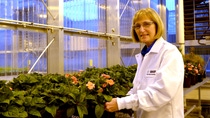Media
Roses and R&D – agricultural solutions for the flower industry

Flowers are the most popular gift on Valentine’s Day, with sales of up to $2 billion dollars in the U.S. every year. To produce such a high number of quality roses, daisies and lilies, greenhouses and nurseries rely on comprehensive solutions to protect plants from a broad range of pests. BASF scientists Renee Keese and Emma Lookabaugh help producers flourish right in time by developing herbicides, fungicides and insecticides for the ornamentals business.
Both of you are scientists for BASF’s ornamental solutions business. What do you do there?
Renee: After completing my PhD at Clemson University in Plant Physiology, I've had an ornamental focus throughout my career, working in various positions in both the field and lab. At BASF, I develop scientific information packages for EPA registration of a product to be used on major flower crops. I am working in Research and Development with numbered compounds, trying to figure out how we are going to use them, how we are going to write the product label, what the directions for use will look like. I work with the early-stage testing, whereas Emma works with the labeled products.
Emma: I received my PhD in Plant Pathology from North Carolina State University and started my career as a seed production scientist with BASF’s vegetable seeds business and its brand Nunhems. I am currently a technical service representative for turf and ornamentals in the Southeast. After we decide to move forward with a formulation and pursue registration, the technical service team steps in to steward the product. We coordinate research testing with university cooperators and private consultants to expand our efficacy and plant safety data. We use this information to develop research-based recommendations to address the needs of our customers. Our goal is to provide sustainable solutions so a big part of what we do is centered around customer-facing training efforts. We develop and update product labels, create technical bulletins and program-approach spray recommendations. We provide training to internal sales colleagues, channel partners and direct to end-users to ensure our products are used responsibly and in the manner intended.
Who are your customers?
Emma: Our customers are commercial greenhouses and nurseries. Often, our customers are suppliers for garden centers and what we call the big box stores, like Lowe's and Home Depot, that also sell plants.
What products do you develop?
Renee: We develop herbicides, insecticides and fungicides that go into the ornamentals market. In general, we go after the pests. There are common pests – whether it is a disease pathogen or an insect – that can be similar across many different flowers or trees. Our products are used on a broad variety of flower crops. Usually, active ingredients are launched for major crops first, such as corn or wheat or soybeans, and then we try to figure out how we can add that into our portfolio for ornamentals.


What is your research focus?
Renee: We need to answer several questions: how well does the product work, what rate do we need to use it, what's the reapplication timing? All those little details. For ornamentals, we have to make sure that the different flowers will tolerate the application of the insecticide or the fungicide. We work with a variety of researchers that test our products against the pests and on 15 or 20 different plant materials to make sure it works. We test on foliage as well as when the plants are in bloom, because that can make a big difference and impact tolerance. We couldn’t ever test all the flowers and all the different cultivars of each flower. Instead, we select the ones that are produced in the biggest numbers, such as roses or poinsettias. A lot of growers understand if it's safe on plant A, it’s most likely safe to use for plant B, too. However, there are especially sensitive plants – succulents or impatiens, for example, and it is more challenging to find the right product fit for them. That is why the average time from discovery in the lab to market launch is 11 to 12 years.
Emma: Product stewardship is our major focus. It takes a long time to develop a new product. With all the effort that goes in to product development, we want to make sure that not only is the product launch successful, but that we are able to keep that product in the market for many years to come. This year is a big year for us, because we are expecting to launch a new fungicide, Avelyo, into the ornamental market. Our priority right now is developing comprehensive training materials so our sales colleagues are prepared for launch.
What’s your personal relationship with flowers?
Emma: My favorite flowers are gardenias. They remind me of my grandmother because she had gardenias planted around her house. Whenever I smell them, I think of her. It is funny that I work in the ornamentals industry because I've never been a huge flower girl. I was never eager to get flowers for Valentine's Day. That all changed during graduate school though. I spent seven years researching Pythium root rot on poinsettias and gained a true appreciation for all the effort that goes into producing a beautiful and disease-free crop.
Renee: May bells, or lily of the valley, are my favorite flowers. I got married in May, years ago, but everything revolved around the fact that I wanted may bells. I wanted them in my bouquet, and they were decorated on the cake and we had the flower everywhere. For me, it is just a very delicate little flower and I love their scent.
For media inquiries and questions, please contact: katharina.meischen@basf.com.